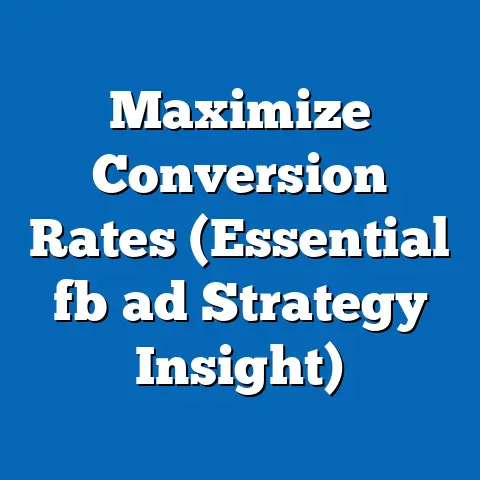Master Facebook Ads Change History (Expert Tips Inside)
Facebook advertising is a dynamic landscape. What works today might need tweaking tomorrow. It’s a world where customizability reigns supreme. We, as marketers, have the power to tailor campaigns with laser precision, choosing from a dizzying array of targeting options, ad formats, and strategies. This flexibility is fantastic, but it also introduces complexity. How do we keep track of all the changes we make? How do we know what’s working and what’s not? That’s where Facebook Ads Change History comes in.
I’ve seen firsthand how neglecting this feature can lead to wasted ad spend and missed opportunities. I remember one campaign where I was testing different ad creatives. I made a few changes, but didn’t document them properly. A week later, I couldn’t remember exactly what I had changed, let alone which version was performing better. It was a frustrating and costly mistake.
Mastering Change History isn’t just about tracking past modifications; it’s about shaping future advertising strategies. It’s about understanding the why behind the performance data. This guide will walk you through everything you need to know, from the basics of Change History to advanced tips for using it to optimize your campaigns and collaborate with your team.
Understanding Facebook Ads Change History
So, what exactly is Facebook Ads Change History? Simply put, it’s a record of all the modifications made to your ad campaigns, ad sets, and ads. Think of it as a digital audit trail, documenting every tweak and adjustment. It’s a crucial feature that provides transparency and accountability in your advertising efforts.
This feature tracks a wide range of changes, including:
- Ad Copy Edits: Any alterations to the text of your ads, headlines, descriptions, and calls to action.
- Targeting Adjustments: Modifications to your audience targeting, such as changes to demographics, interests, behaviors, and custom audiences.
- Budget Changes: Increases or decreases in your daily or lifetime budgets.
- Bidding Strategy Updates: Adjustments to your bidding strategy, such as switching from manual bidding to automated bidding.
- Ad Creative Swaps: Changes to the images or videos used in your ads.
- Placement Modifications: Adjustments to where your ads are shown, such as selecting or deselecting specific placements.
- Campaign Status Changes: Starting, pausing, or ending campaigns, ad sets, or ads.
Accessing the Change History is straightforward. Within the Facebook Ads Manager, navigate to the campaign, ad set, or ad you want to examine. Look for the “Change History” option, typically found in the dropdown menu or within the “Edit” section. Clicking on it will display a chronological list of all the changes made, along with the date, time, and the user who made the modification.
It’s important to emphasize the necessity of maintaining an accurate record of these changes. This meticulous documentation forms the foundation of effective campaign analysis and reporting. Without it, you’re essentially flying blind, unable to pinpoint the factors that are driving your results.
Key Takeaway: Facebook Ads Change History is your campaign’s memory. Treat it as a vital resource for understanding and improving your advertising performance.
Why Change History Matters for Advertisers
The benefits of utilizing Change History extend far beyond mere record-keeping. It’s a powerful tool for campaign optimization, providing insights that can dramatically improve your results.
One of the most significant advantages is the ability to identify what strategies or techniques were successful or unsuccessful. Let’s say you noticed a sudden spike in your click-through rate (CTR) after making a few adjustments to your ad copy. By reviewing the Change History, you can pinpoint the exact changes that triggered this positive response. Was it a new headline? A different call to action? Once you know what worked, you can replicate that success in other campaigns.
Conversely, Change History can also help you identify what didn’t work. If you see a decline in conversions after making a change to your targeting, you can quickly revert to the previous settings and avoid further losses.
Advertisers can leverage historical data to make informed decisions for future campaigns. By analyzing patterns in your Change History, you can develop a deeper understanding of your audience, your ad creative, and your bidding strategies. This knowledge empowers you to make more strategic choices, leading to better ROI.
I remember working on a campaign for a local restaurant. We were struggling to get consistent results. After digging into the Change History, I noticed that our best-performing ads were the ones that featured user-generated content (UGC). We had initially dismissed UGC as less professional, but the data clearly showed that it resonated with our target audience. We doubled down on UGC, and our campaign performance soared.
Key Takeaway: Change History transforms data into actionable insights. Use it to understand the impact of your changes and make smarter decisions.
Expert Tips for Navigating Change History
Now that you understand the importance of Change History, let’s dive into some expert tips for using it effectively.
Tip 1: Regularly Review Your Change History
This may seem obvious, but it’s a step that many advertisers overlook. The frequency of your reviews will depend on the pace of your campaigns. If you’re making frequent changes, you should check your Change History daily or every other day. If your campaigns are more stable, a weekly review may suffice.
The key is to establish a routine and stick to it. Don’t wait until you see a problem to start digging into your Change History. Proactive monitoring will help you catch issues early and identify opportunities for improvement.
Tip 2: Use Change History to A/B Test Effectively
A/B testing is a cornerstone of effective Facebook advertising. But simply running A/B tests isn’t enough. You need to carefully track and analyze the results. Change History can be invaluable in this process.
When setting up an A/B test, make sure to document all the changes you’re making. For example, if you’re testing two different headlines, note the exact wording of each headline in your Change History. This will make it much easier to compare the performance of the two versions and draw meaningful conclusions.
Here are some examples of effective A/B tests you can conduct using insights from Change History:
- Headline Testing: Experiment with different headlines to see which ones generate the highest CTR.
- Image Testing: Test different images or videos to see which ones resonate most with your audience.
- Call-to-Action Testing: Try different calls to action to see which ones drive the most conversions.
- Audience Targeting Testing: Compare the performance of different audience segments to identify your most responsive targets.
Tip 3: Leverage Change History for Team Collaboration
If you’re working on a team, Change History can be a powerful tool for collaboration. It allows everyone to stay on the same page and understand the rationale behind different decisions.
Encourage team members to document their changes thoroughly. When making a modification, include a brief explanation of why you’re making the change and what you hope to achieve. This will help other team members understand your thought process and avoid making conflicting changes.
I’ve found that creating a shared document (like a Google Doc or a spreadsheet) to track changes can be incredibly helpful. This document can include details such as the date of the change, the specific modification made, the rationale behind the change, and the expected impact.
Tip 4: Stay Updated with Facebook Ads Changes
Facebook is constantly evolving. New features are introduced, existing features are modified, and best practices change. It’s crucial to stay informed about these changes to ensure that your campaigns remain effective.
Facebook often announces updates and changes on its official blog, in its help center, and through its advertising support channels. Make it a habit to check these resources regularly. You can also follow industry experts and thought leaders on social media to stay abreast of the latest trends.
Tip 5: Utilize Third-Party Tools for Enhanced Analysis
While Facebook’s Change History is a valuable tool, it has its limitations. It can be difficult to analyze large volumes of data or to track changes across multiple campaigns. That’s where third-party tools come in.
- Automated Change Tracking: Automatically track all changes made to your campaigns, without requiring manual documentation.
- Performance Reporting: Generate detailed reports on the impact of different changes on your campaign performance.
- Anomaly Detection: Identify unusual patterns or anomalies in your data, which may indicate problems or opportunities.
- Collaboration Features: Facilitate team collaboration by allowing team members to share insights and track changes together.
Some popular tools include:
- Funnel: This tool integrates with Facebook Ads and other marketing platforms to provide a unified view of your data.
- Supermetrics: This tool allows you to pull data from Facebook Ads into Google Sheets, Google Data Studio, and other reporting platforms.
- Whatagraph: This tool provides visually appealing reports on your Facebook Ads performance.
Key Takeaway: These expert tips will help you unlock the full potential of Change History and transform it into a powerful tool for campaign optimization and team collaboration.
Real-World Examples and Case Studies
Let’s look at a couple of real-world examples of businesses that have successfully utilized Change History to pivot their strategies and achieve better results.
Example 1: E-commerce Store Optimizes Ad Copy
An e-commerce store selling handmade jewelry noticed a decline in sales despite maintaining a consistent ad spend. By reviewing their Change History, they discovered that a recent change to their ad copy, intended to be more concise, had inadvertently removed key details about the craftsmanship and materials used in their products. They reverted to the original ad copy, highlighting the unique aspects of their jewelry, and saw an immediate increase in sales.
Example 2: SaaS Company Improves Targeting
A SaaS company targeting small businesses was experiencing low conversion rates from their Facebook Ads. After analyzing their Change History, they realized that they had been too broad in their targeting, reaching many businesses that weren’t a good fit for their product. They refined their targeting to focus on specific industries and job titles, resulting in a significant improvement in their conversion rates.
In both of these examples, Change History played a crucial role in identifying the root cause of the problem and enabling the businesses to make informed adjustments that led to improved performance.
Key Takeaway: These case studies demonstrate the tangible benefits of using Change History to understand and optimize your Facebook Ads campaigns.
Conclusion
Mastering Facebook Ads Change History is not just a nice-to-have skill; it’s a necessity for any serious advertiser. It’s the key to understanding the impact of your changes, making informed decisions, and driving better results.
I encourage you to take a proactive approach in tracking and analyzing your changes. Don’t wait until you see a problem to start digging into your Change History. By establishing a routine and following the expert tips outlined in this guide, you can unlock the full potential of this powerful tool.
Remember, the digital marketing landscape is constantly evolving. By mastering Change History and staying informed about the latest trends, you can enhance your advertising effectiveness and stay ahead of the competition. With the right insights and adjustments, you can transform your Facebook Ads campaigns from a source of frustration into a powerful engine for growth.






